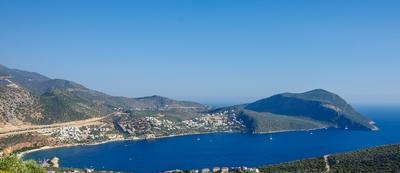|
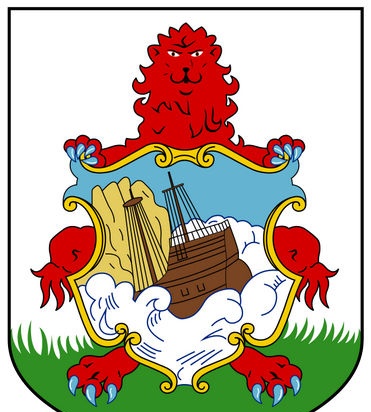 Hamilton, the capital of Bermuda, covers an area of only 180 acres, or approximately 86 hectares. You can get around it without missing a single street, about three hours. Hamilton, the capital of Bermuda, covers an area of only 180 acres, or approximately 86 hectares. You can get around it without missing a single street, about three hours.
However, it has everything inherent in any capital city, with the exception, perhaps, of the metro and trolleybus, and even underground passages. Hamilton has two "skyscrapers" up to a dozen stories high, which house the hotel and the bank. There is a port, there are many shops where you can buy practically everything. The city has restaurants, bars, nightclubs with variety shows, three cinemas and two theaters. The so-called National Theater is almost in disrepair: the doors are boarded up crosswise, there are no glass in the windows, and the plaster has peeled off. The fact that this is a theater can only be judged by the sign above the entrance. But this is perhaps the only building that looks so gloomy and abandoned against a generally different background.
The fact that Hamilton is the capital (administrative center) and the largest city of the colony is beyond doubt (although it is significantly smaller than St. George, the latter does not have city status). Both geographically and administratively, it occupies a central, middle position. From the airport, located in the eastern part of the archipelago, a good hour by car. Approximately the same distance to the capital and from its western outskirts.
By the way, a few words about the airport. It is located on the territory of the American Kindley Air Force Base and is called "Kindley Field". Having learned about this, I must admit that I was somewhat surprised at such an unusual "coexistence". But everything was explained simply: the military base allocated two runways for the civil airport after the British colony became a resort for the Americans. The territory of the airfield is not so large in size that one is involuntarily surprised: how do the pilots manage to land their bulky passenger "Boeings" here?
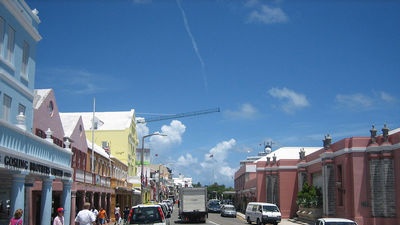 The path to Hamilton from the airport lies across Castle Harbor. Then you can move around Harrington Sound from the north or south. The scenic road winds and winds among bluish-gray rocks along the narrow strip of land that separates Castle Harbor and Harrington Sound, and then bursts into the wildest part of the main island. For four miles the path of the ocean is not visible at all, although the island is not more than a mile wide. The uneven surface of the earth strikes the imagination with bizarre heaps of white soft stone, small glades of fat fertile soil and lush vegetation. The most common tree on the islands is the so-called Bermuda cedar, also referred to as the Virginia juniper. Bermuda cedar is extremely decorative and industrial value at the same time. Other trees, among which there are many royal palms, are common in any subtropical zone. And flowers are everywhere: in wild glades, in rare groves, in the front gardens of houses. There are whole fields of wild Bermuda lilies, which are bred on the islands for sale and exported to many countries. The path to Hamilton from the airport lies across Castle Harbor. Then you can move around Harrington Sound from the north or south. The scenic road winds and winds among bluish-gray rocks along the narrow strip of land that separates Castle Harbor and Harrington Sound, and then bursts into the wildest part of the main island. For four miles the path of the ocean is not visible at all, although the island is not more than a mile wide. The uneven surface of the earth strikes the imagination with bizarre heaps of white soft stone, small glades of fat fertile soil and lush vegetation. The most common tree on the islands is the so-called Bermuda cedar, also referred to as the Virginia juniper. Bermuda cedar is extremely decorative and industrial value at the same time. Other trees, among which there are many royal palms, are common in any subtropical zone. And flowers are everywhere: in wild glades, in rare groves, in the front gardens of houses. There are whole fields of wild Bermuda lilies, which are bred on the islands for sale and exported to many countries.
With the exception of barren areas of coral reefs and basalt heaps, which are most on the northern coast, there are no empty areas on the island. Each piece of land is used for flower, berry, fruit or vegetable planting.
The houses are built with great taste and imagination, regardless of whether the plot of land taken for construction is convenient or not. If the cottage is on a hill, then from the house to the foot of the hillock, steps of roughly hewn stones run down in terraces. The paths in the front gardens are also covered with stone.However, most of the houses, so dissimilar in appearance to each other, have one thing in common - the color of the roofs: white or silver, reflecting the sun's rays and protecting the housing from excessive overheating.
These are the suburbs of Hamilton. The capital looks about the same, but to this it is necessary to add the quarters of houses huddled together in height, in contrast to cottages and mansions of two or three floors. But even here, in the gaps between the houses in the very center of the city, you can come across small areas of shrub thickets, which, you can be sure, are not "no man's" land. These are either reserved plantings (although there are few of them), protected by the authorities, or the property of wealthy owners, who are listed as backyard, home parks. And the proof of this is all the same signs with the inscription: “Entry prohibited. Private property".
The streets of Hamilton are lined up strictly vertically and horizontally, as in New York or St. Petersburg. It is impossible to get confused. This is understandable, because Hamilton is a relatively young city (it is 203 years younger than St. George) and was built up according to a specially developed plan, and not chaotically. Architects deliberately gave it the severity and gloss of the capital city.
Hamilton's main thoroughfare, trade and business artery is Frant Street. Unlike many port and non-port cities in the world, in which the main streets are hidden in the depths of the city center, Front Street is located "on the edge" and runs along the quays of the passenger port. It begins at the confluence of a suburban highway with one of the vertically located streets, Queen Street, in the very place where the only in the city and almost always empty police booth flaunts on a zebra-painted asphalt triangle. The houses on this street are located on one side only. On the other hand, there is the bay and the harbor, on the shore of which the buildings of the customs and the sea station are huddled. And yet, despite the "one-sidedness" of the street, the city's business life is concentrated here.
The whole block from Queen Street to Barnaby Street is occupied by shops with colorful display windows. On opposite corners of Barnaby Street, as if deliberately fenced off from each other by the street, the offices of two rival banks were located.
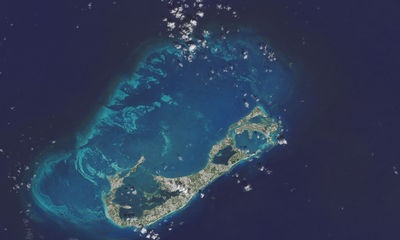 Behind the bank offices in a Moroccan-style house with a gallery separated from the street by a row of thin columns, the offices of a number of foreign airlines huddled closely together. Not far from the sea station is the building of the Colonial Secretariat. It contains all government offices, as well as the treasury, which, among other valuables, contains the "sword of the state" (it is believed that he visited the crusades), a silver oar with the date "1697", which served as a symbol of the Bermuda vice admiralty. Behind the bank offices in a Moroccan-style house with a gallery separated from the street by a row of thin columns, the offices of a number of foreign airlines huddled closely together. Not far from the sea station is the building of the Colonial Secretariat. It contains all government offices, as well as the treasury, which, among other valuables, contains the "sword of the state" (it is believed that he visited the crusades), a silver oar with the date "1697", which served as a symbol of the Bermuda vice admiralty.
Behind the quarter occupied by the Colonial Secretariat, at the highest point in the city is the House of Sessions and the Supreme Court of the colony.
The most attractive places in Hamilton are, perhaps, the estate of Par-la-Ville, the Post Post Office, and also the Hale House, or Apothecary Hall. All these three houses are closely related. Apothecaryse Hall, or, more simply, a pharmacy, was built by the American Southerner Hale in 1860. It is said that the pharmacist Hale and the postmaster Perot, despite their very modest occupations, left a rather noticeable mark on the history of the colony.
At that time, postage stamps were not yet in use in Bermuda. If a person needed to send a letter, they had to bring it to the post office, pay money for sending, and then an ink stamp was put on the envelope indicating the cost of the parcel. Such work required Perot to be constantly present in the office. The office was in the corner room of his house on the ground floor, and Hale, who had not yet built his own pharmacy, often stopped by to help a friend send letters.
But Perot considered this method extremely inconvenient.Hale then suggested: why not sell postage stamps in whole sheets? For example, twelve pieces per sheet for one shilling. Then the senders of the letters, without resorting to the help of the postmaster, would cut the stamps from the sheet themselves, glue them on envelopes and put them in a box that could be hung on the door of the post office ... This is how the "Perot stamps" appeared. Nowadays there are only a few of these brands. They can only be acquired by chance.
But back to Par-la-Ville. A huge rubber tree grows in front of the house, by the way the only one on the island. It was brought from distant British Guiana in 1847 by William Perot as a gift to Hale. The Hevea tree quickly acclimatized, took root and ... far outlived its owners. This old hevea formed the basis of a picturesque park, now similar to a botanical garden with a collection of island flora, founded by William Perot.
Today, the Perot House houses a public library, the main book depository of the colony with a branch in St. George. It contains more than 40 thousand volumes of books in different languages. In addition, visitors are offered a very wide selection of English, French and American periodicals.
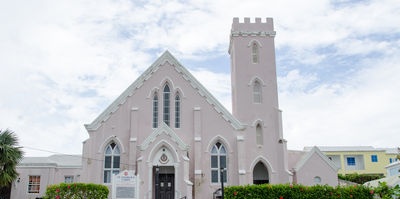 However, despite the rich selection of literature collected in the library, which should personify the Bermudians' love for reading, for the book, I have not seen a single specialized bookstore in Hamilton. Only in one rather ordinary shop, selling all kinds of haberdashery and souvenir consumer goods and colored postcards, did I find a corner with books and magazines. Literature was presented mainly by American bestsellers, or rather, reading books at a price below a dollar, with half-naked beauties depicted on the covers and elegant supermen with colts and hard drives in their hands. Against the background of all this frivolous literature, stacks of fresh newspapers were almost completely lost. But the newspapers were still sold out, and the magazines, despite their inviting advertising "beauty", continued to lie sadly in their places. However, despite the rich selection of literature collected in the library, which should personify the Bermudians' love for reading, for the book, I have not seen a single specialized bookstore in Hamilton. Only in one rather ordinary shop, selling all kinds of haberdashery and souvenir consumer goods and colored postcards, did I find a corner with books and magazines. Literature was presented mainly by American bestsellers, or rather, reading books at a price below a dollar, with half-naked beauties depicted on the covers and elegant supermen with colts and hard drives in their hands. Against the background of all this frivolous literature, stacks of fresh newspapers were almost completely lost. But the newspapers were still sold out, and the magazines, despite their inviting advertising "beauty", continued to lie sadly in their places.
On the eastern outskirts of Hamilton, near the port, there is a house occupied by the Bermuda Historical Society. Outwardly, it does not stand out in any way and resembles an ordinary residential building of the New England period. Now the building houses a museum. It contains drawings, engravings, photo reproductions of paintings with sketches of scenes from local life. Samples of medieval furniture, silverware made by local craftsmen are very curious. Of particular interest are the drawings of a light, very narrow and clearly fast sailing vessel built here in Bermuda. This ship took part in the blockade of American ports occupied by the Confederates during the American Civil War.
The most significant and, one might say, the most impressive building in Hamilton is the cathedral. Its spire rises high above the city and is visible from different points.
They say that once upon a time there was an unprepossessing Anglican church on the site of the cathedral. But in 1884, for an unknown reason, a fire broke out in it, which destroyed the entire building to the ground. And then it was decided to erect a large cathedral on the site of the ashes. Although the construction took exactly a quarter of a century, church services began much earlier. When the building was completely ready, the cathedral was named Bermuda Cathedral by a special legislative act.
Hamilton is rightly called the city of churches. There are really a lot of them for such a small town. One church here accounts for about two hundred inhabitants. The churches were built at different times, according to different designs and represent different eras and different religious trends.
Going to the outskirts of Hamilton and turning into a stone hole, along the bottom of which is a road carved into the rock and overgrown with ivy, after a few minutes walk you find yourself right in front of the gate of Fort Hamilton - a wonderful monument of antiquity.
In the middle of the 19th century, during the reign of Queen Victoria, the British Empire sought to turn Bermuda into a kind of "western Gibraltar".Millions of pounds were spent on the construction of thirteen powerful fortifications located in strategically important areas of the largest island in the archipelago - Bermuda.
The construction of the fort, begun in 1866, was completed only in 1889. The fort is armed with seven 18-ton cannons, barrel-loaded and firing 400-pound bombs.
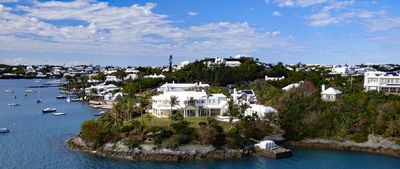 Despite the huge funds spent on its construction, the fort was never fully equipped with the necessary number of soldiers. Firstly, there was no need for this, and secondly, sanitary conditions did not allow. In 1900, it was simply abandoned and empty until 1963, when the city authorities restored it and proclaimed it a Victorian monument. Despite the huge funds spent on its construction, the fort was never fully equipped with the necessary number of soldiers. Firstly, there was no need for this, and secondly, sanitary conditions did not allow. In 1900, it was simply abandoned and empty until 1963, when the city authorities restored it and proclaimed it a Victorian monument.
Residents love to wander along the walls of the fort, surrounded by a wooden fence, sit astride the trunks of three surviving cannons and admire the view of the city, go into the cool underground galleries where shells and gunpowder were stored, and also visit the tea room, although located in one of the casemates, but which has nothing to do with the history of the fort. It is curious that the fort is closed for visits at exactly five o'clock in the afternoon, that is, at the hour of the beginning of the traditional British tea drinking.
Despite the abundance of sights, locals rarely visit them, unless they go to the cinema in the evening. Families of white Bermudians usually live separately. The wealthier have their own villas. Less wealthy, but still wealthy people live in suburban cottages. Most of the people of color build modest houses for themselves in the countryside.
Despite the outward well-being, life on the islands, in my opinion, is boring and monotonous. A person is looking for novelty, impressions, sensations, he is attracted to movement. Here it is impossible. For those who come to the archipelago for a relatively short time, everything is interesting, everything is unusual. Local residents are suffocating in the swamp of the philistine.
Rozanov D.V. - On a fragment of Atlantis
|
 Hamilton, the capital of Bermuda, covers an area of only 180 acres, or approximately 86 hectares. You can get around it without missing a single street, about three hours.
Hamilton, the capital of Bermuda, covers an area of only 180 acres, or approximately 86 hectares. You can get around it without missing a single street, about three hours. The path to Hamilton from the airport lies across Castle Harbor. Then you can move around Harrington Sound from the north or south. The scenic road winds and winds among bluish-gray rocks along the narrow strip of land that separates Castle Harbor and Harrington Sound, and then bursts into the wildest part of the main island. For four miles the path of the ocean is not visible at all, although the island is not more than a mile wide. The uneven surface of the earth strikes the imagination with bizarre heaps of white soft stone, small glades of fat fertile soil and lush vegetation. The most common tree on the islands is the so-called Bermuda cedar, also referred to as the Virginia juniper. Bermuda cedar is extremely decorative and industrial value at the same time. Other trees, among which there are many royal palms, are common in any subtropical zone. And flowers are everywhere: in wild glades, in rare groves, in the front gardens of houses. There are whole fields of wild Bermuda lilies, which are bred on the islands for sale and exported to many countries.
The path to Hamilton from the airport lies across Castle Harbor. Then you can move around Harrington Sound from the north or south. The scenic road winds and winds among bluish-gray rocks along the narrow strip of land that separates Castle Harbor and Harrington Sound, and then bursts into the wildest part of the main island. For four miles the path of the ocean is not visible at all, although the island is not more than a mile wide. The uneven surface of the earth strikes the imagination with bizarre heaps of white soft stone, small glades of fat fertile soil and lush vegetation. The most common tree on the islands is the so-called Bermuda cedar, also referred to as the Virginia juniper. Bermuda cedar is extremely decorative and industrial value at the same time. Other trees, among which there are many royal palms, are common in any subtropical zone. And flowers are everywhere: in wild glades, in rare groves, in the front gardens of houses. There are whole fields of wild Bermuda lilies, which are bred on the islands for sale and exported to many countries. Behind the bank offices in a Moroccan-style house with a gallery separated from the street by a row of thin columns, the offices of a number of foreign airlines huddled closely together. Not far from the sea station is the building of the Colonial Secretariat. It contains all government offices, as well as the treasury, which, among other valuables, contains the "sword of the state" (it is believed that he visited the crusades), a silver oar with the date "1697", which served as a symbol of the Bermuda vice admiralty.
Behind the bank offices in a Moroccan-style house with a gallery separated from the street by a row of thin columns, the offices of a number of foreign airlines huddled closely together. Not far from the sea station is the building of the Colonial Secretariat. It contains all government offices, as well as the treasury, which, among other valuables, contains the "sword of the state" (it is believed that he visited the crusades), a silver oar with the date "1697", which served as a symbol of the Bermuda vice admiralty. However, despite the rich selection of literature collected in the library, which should personify the Bermudians' love for reading, for the book, I have not seen a single specialized bookstore in Hamilton. Only in one rather ordinary shop, selling all kinds of haberdashery and souvenir consumer goods and colored postcards, did I find a corner with books and magazines. Literature was presented mainly by American bestsellers, or rather, reading books at a price below a dollar, with half-naked beauties depicted on the covers and elegant supermen with colts and hard drives in their hands. Against the background of all this frivolous literature, stacks of fresh newspapers were almost completely lost. But the newspapers were still sold out, and the magazines, despite their inviting advertising "beauty", continued to lie sadly in their places.
However, despite the rich selection of literature collected in the library, which should personify the Bermudians' love for reading, for the book, I have not seen a single specialized bookstore in Hamilton. Only in one rather ordinary shop, selling all kinds of haberdashery and souvenir consumer goods and colored postcards, did I find a corner with books and magazines. Literature was presented mainly by American bestsellers, or rather, reading books at a price below a dollar, with half-naked beauties depicted on the covers and elegant supermen with colts and hard drives in their hands. Against the background of all this frivolous literature, stacks of fresh newspapers were almost completely lost. But the newspapers were still sold out, and the magazines, despite their inviting advertising "beauty", continued to lie sadly in their places. Despite the huge funds spent on its construction, the fort was never fully equipped with the necessary number of soldiers. Firstly, there was no need for this, and secondly, sanitary conditions did not allow. In 1900, it was simply abandoned and empty until 1963, when the city authorities restored it and proclaimed it a Victorian monument.
Despite the huge funds spent on its construction, the fort was never fully equipped with the necessary number of soldiers. Firstly, there was no need for this, and secondly, sanitary conditions did not allow. In 1900, it was simply abandoned and empty until 1963, when the city authorities restored it and proclaimed it a Victorian monument.
